JUC工具类: CountDownLatch详解
CountDownLatch底层也是由AQS,用来同步一个或多个任务的常用并发工具类,强制它们等待由其他任务执行的一组操作完成。@pdai
带着BAT大厂的面试问题去理解
提示
请带着这些问题继续后文,会很大程度上帮助你更好的理解相关知识点。@pdai
- 什么是CountDownLatch?
- CountDownLatch底层实现原理?
- CountDownLatch一次可以唤醒几个任务? 多个
- CountDownLatch有哪些主要方法? await(),countDown()
- CountDownLatch适用于什么场景?
- 写道题:实现一个容器,提供两个方法,add,size 写两个线程,线程1添加10个元素到容器中,线程2实现监控元素的个数,当个数到5个时,线程2给出提示并结束? 使用CountDownLatch 代替wait notify 好处。
CountDownLatch介绍
从源码可知,其底层是由AQS提供支持,所以其数据结构可以参考AQS的数据结构,而AQS的数据结构核心就是两个虚拟队列: 同步队列sync queue 和条件队列condition queue,不同的条件会有不同的条件队列。CountDownLatch典型的用法是将一个程序分为n个互相独立的可解决任务,并创建值为n的CountDownLatch。当每一个任务完成时,都会在这个锁存器上调用countDown,等待问题被解决的任务调用这个锁存器的await,将他们自己拦住,直至锁存器计数结束。
CountDownLatch源码分析
类的继承关系
CountDownLatch没有显示继承哪个父类或者实现哪个父接口, 它底层是AQS是通过内部类Sync来实现的。
public class CountDownLatch {}
类的内部类
CountDownLatch类存在一个内部类Sync,继承自AbstractQueuedSynchronizer,其源代码如下。
private static final class Sync extends AbstractQueuedSynchronizer {
// 版本号
private static final long serialVersionUID = 4982264981922014374L;
// 构造器
Sync(int count) {
setState(count);
}
// 返回当前计数
int getCount() {
return getState();
}
// 试图在共享模式下获取对象状态
protected int tryAcquireShared(int acquires) {
return (getState() == 0) ? 1 : -1;
}
// 试图设置状态来反映共享模式下的一个释放
protected boolean tryReleaseShared(int releases) {
// Decrement count; signal when transition to zero
// 无限循环
for (;;) {
// 获取状态
int c = getState();
if (c == 0) // 没有被线程占有
return false;
// 下一个状态
int nextc = c-1;
if (compareAndSetState(c, nextc)) // 比较并且设置成功
return nextc == 0;
}
}
}
说明: 对CountDownLatch方法的调用会转发到对Sync或AQS的方法的调用,所以,AQS对CountDownLatch提供支持。
类的属性
可以看到CountDownLatch类的内部只有一个Sync类型的属性:
public class CountDownLatch {
// 同步队列
private final Sync sync;
}
类的构造函数
public CountDownLatch(int count) {
if (count < 0) throw new IllegalArgumentException("count < 0");
// 初始化状态数
this.sync = new Sync(count);
}
说明: 该构造函数可以构造一个用给定计数初始化的CountDownLatch,并且构造函数内完成了sync的初始化,并设置了状态数。
核心函数 - await函数
此函数将会使当前线程在锁存器倒计数至零之前一直等待,除非线程被中断。其源码如下
public void await() throws InterruptedException {
// 转发到sync对象上
sync.acquireSharedInterruptibly(1);
}
说明: 由源码可知,对CountDownLatch对象的await的调用会转发为对Sync的acquireSharedInterruptibly(从AQS继承的方法)方法的调用。
- acquireSharedInterruptibly源码如下:
public final void acquireSharedInterruptibly(int arg)
throws InterruptedException {
if (Thread.interrupted())
throw new InterruptedException();
if (tryAcquireShared(arg) < 0)
doAcquireSharedInterruptibly(arg);
}
说明: 从源码中可知,acquireSharedInterruptibly又调用了CountDownLatch的内部类Sync的tryAcquireShared和AQS的doAcquireSharedInterruptibly函数。
- tryAcquireShared函数的源码如下:
protected int tryAcquireShared(int acquires) {
return (getState() == 0) ? 1 : -1;
}
说明: 该函数只是简单的判断AQS的state是否为0,为0则返回1,不为0则返回-1。
- doAcquireSharedInterruptibly函数的源码如下:
private void doAcquireSharedInterruptibly(int arg) throws InterruptedException {
// 添加节点至等待队列
final Node node = addWaiter(Node.SHARED);
boolean failed = true;
try {
for (;;) { // 无限循环
// 获取node的前驱节点
final Node p = node.predecessor();
if (p == head) { // 前驱节点为头节点
// 试图在共享模式下获取对象状态
int r = tryAcquireShared(arg);
if (r >= 0) { // 获取成功
// 设置头节点并进行繁殖
setHeadAndPropagate(node, r);
// 设置节点next域
p.next = null; // help GC
failed = false;
return;
}
}
if (shouldParkAfterFailedAcquire(p, node) &&
parkAndCheckInterrupt()) // 在获取失败后是否需要禁止线程并且进行中断检查
// 抛出异常
throw new InterruptedException();
}
} finally {
if (failed)
cancelAcquire(node);
}
}
说明: 在AQS的doAcquireSharedInterruptibly中可能会再次调用CountDownLatch的内部类Sync的tryAcquireShared方法和AQS的setHeadAndPropagate方法。
- setHeadAndPropagate方法源码如下。
private void setHeadAndPropagate(Node node, int propagate) {
// 获取头节点
Node h = head; // Record old head for check below
// 设置头节点
setHead(node);
/*
* Try to signal next queued node if:
* Propagation was indicated by caller,
* or was recorded (as h.waitStatus either before
* or after setHead) by a previous operation
* (note: this uses sign-check of waitStatus because
* PROPAGATE status may transition to SIGNAL.)
* and
* The next node is waiting in shared mode,
* or we don't know, because it appears null
*
* The conservatism in both of these checks may cause
* unnecessary wake-ups, but only when there are multiple
* racing acquires/releases, so most need signals now or soon
* anyway.
*/
// 进行判断
if (propagate > 0 || h == null || h.waitStatus < 0 ||
(h = head) == null || h.waitStatus < 0) {
// 获取节点的后继
Node s = node.next;
if (s == null || s.isShared()) // 后继为空或者为共享模式
// 以共享模式进行释放
doReleaseShared();
}
}
说明: 该方法设置头节点并且释放头节点后面的满足条件的结点,该方法中可能会调用到AQS的doReleaseShared方法,其源码如下。
private void doReleaseShared() {
/*
* Ensure that a release propagates, even if there are other
* in-progress acquires/releases. This proceeds in the usual
* way of trying to unparkSuccessor of head if it needs
* signal. But if it does not, status is set to PROPAGATE to
* ensure that upon release, propagation continues.
* Additionally, we must loop in case a new node is added
* while we are doing this. Also, unlike other uses of
* unparkSuccessor, we need to know if CAS to reset status
* fails, if so rechecking.
*/
// 无限循环
for (;;) {
// 保存头节点
Node h = head;
if (h != null && h != tail) { // 头节点不为空并且头节点不为尾结点
// 获取头节点的等待状态
int ws = h.waitStatus;
if (ws == Node.SIGNAL) { // 状态为SIGNAL
if (!compareAndSetWaitStatus(h, Node.SIGNAL, 0)) // 不成功就继续
continue; // loop to recheck cases
// 释放后继结点
unparkSuccessor(h);
}
else if (ws == 0 &&
!compareAndSetWaitStatus(h, 0, Node.PROPAGATE)) // 状态为0并且不成功,继续
continue; // loop on failed CAS
}
if (h == head) // 若头节点改变,继续循环
break;
}
}
说明: 该方法在共享模式下释放,具体的流程再之后会通过一个示例给出。
所以,对CountDownLatch的await调用大致会有如下的调用链。
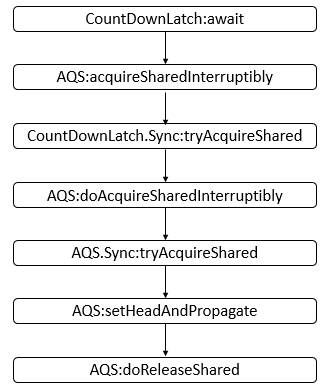
说明: 上图给出了可能会调用到的主要方法,并非一定会调用到,之后,会通过一个示例给出详细的分析。
核心函数 - countDown函数
此函数将递减锁存器的计数,如果计数到达零,则释放所有等待的线程
public void countDown() {
sync.releaseShared(1);
}
说明: 对countDown的调用转换为对Sync对象的releaseShared(从AQS继承而来)方法的调用。
- releaseShared源码如下
public final boolean releaseShared(int arg) {
if (tryReleaseShared(arg)) {
doReleaseShared();
return true;
}
return false;
}
说明: 此函数会以共享模式释放对象,并且在函数中会调用到CountDownLatch的tryReleaseShared函数,并且可能会调用AQS的doReleaseShared函数。
- tryReleaseShared源码如下
protected boolean tryReleaseShared(int releases) {
// Decrement count; signal when transition to zero
// 无限循环
for (;;) {
// 获取状态
int c = getState();
if (c == 0) // 没有被线程占有
return false;
// 下一个状态
int nextc = c-1;
if (compareAndSetState(c, nextc)) // 比较并且设置成功
return nextc == 0;
}
}
说明: 此函数会试图设置状态来反映共享模式下的一个释放。具体的流程在下面的示例中会进行分析。
- AQS的doReleaseShared的源码如下
private void doReleaseShared() {
/*
* Ensure that a release propagates, even if there are other
* in-progress acquires/releases. This proceeds in the usual
* way of trying to unparkSuccessor of head if it needs
* signal. But if it does not, status is set to PROPAGATE to
* ensure that upon release, propagation continues.
* Additionally, we must loop in case a new node is added
* while we are doing this. Also, unlike other uses of
* unparkSuccessor, we need to know if CAS to reset status
* fails, if so rechecking.
*/
// 无限循环
for (;;) {
// 保存头节点
Node h = head;
if (h != null && h != tail) { // 头节点不为空并且头节点不为尾结点
// 获取头节点的等待状态
int ws = h.waitStatus;
if (ws == Node.SIGNAL) { // 状态为SIGNAL
if (!compareAndSetWaitStatus(h, Node.SIGNAL, 0)) // 不成功就继续
continue; // loop to recheck cases
// 释放后继结点
unparkSuccessor(h);
}
else if (ws == 0 &&
!compareAndSetWaitStatus(h, 0, Node.PROPAGATE)) // 状态为0并且不成功,继续
continue; // loop on failed CAS
}
if (h == head) // 若头节点改变,继续循环
break;
}
}
说明: 此函数在共享模式下释放资源。
所以,对CountDownLatch的countDown调用大致会有如下的调用链。
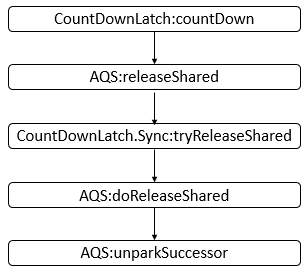
说明: 上图给出了可能会调用到的主要方法,并非一定会调用到,之后,会通过一个示例给出详细的分析。
CountDownLatch示例
下面给出了一个使用CountDownLatch的示例。
import java.util.concurrent.CountDownLatch;
class MyThread extends Thread {
private CountDownLatch countDownLatch;
public MyThread(String name, CountDownLatch countDownLatch) {
super(name);
this.countDownLatch = countDownLatch;
}
public void run() {
System.out.println(Thread.currentThread().getName() + " doing something");
try {
Thread.sleep(1000);
} catch (InterruptedException e) {
e.printStackTrace();
}
System.out.println(Thread.currentThread().getName() + " finish");
countDownLatch.countDown();
}
}
public class CountDownLatchDemo {
public static void main(String[] args) {
CountDownLatch countDownLatch = new CountDownLatch(2);
MyThread t1 = new MyThread("t1", countDownLatch);
MyThread t2 = new MyThread("t2", countDownLatch);
t1.start();
t2.start();
System.out.println("Waiting for t1 thread and t2 thread to finish");
try {
countDownLatch.await();
} catch (InterruptedException e) {
e.printStackTrace();
}
System.out.println(Thread.currentThread().getName() + " continue");
}
}
运行结果(某一次):
Waiting for t1 thread and t2 thread to finish
t1 doing something
t2 doing something
t1 finish
t2 finish
main continue
说明: 本程序首先计数器初始化为2。根据结果,可能会存在如下的一种时序图。
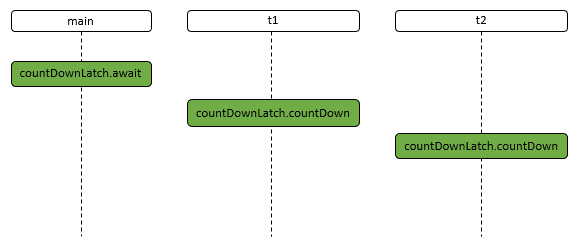
说明: 首先main线程会调用await操作,此时main线程会被阻塞,等待被唤醒,之后t1线程执行了countDown操作,最后,t2线程执行了countDown操作,此时main线程就被唤醒了,可以继续运行。下面,进行详细分析。
- main线程执行countDownLatch.await操作,主要调用的函数如下。
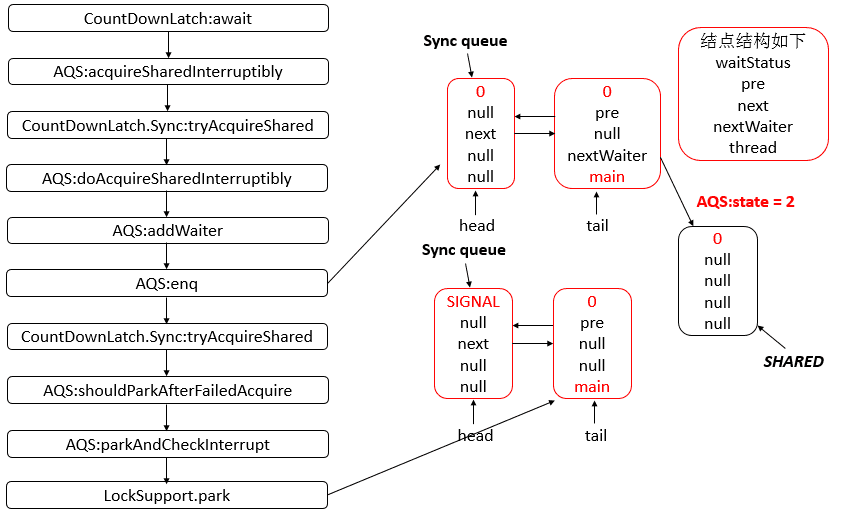
说明: 在最后,main线程就被park了,即禁止运行了。此时Sync queue(同步队列)中有两个节点,AQS的state为2,包含main线程的结点的nextWaiter指向SHARED结点。
- t1线程执行countDownLatch.countDown操作,主要调用的函数如下。
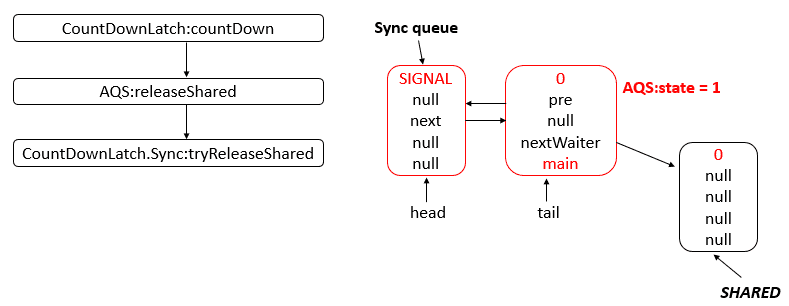
说明: 此时,Sync queue队列里的结点个数未发生变化,但是此时,AQS的state已经变为1了。
- t2线程执行countDownLatch.countDown操作,主要调用的函数如下。
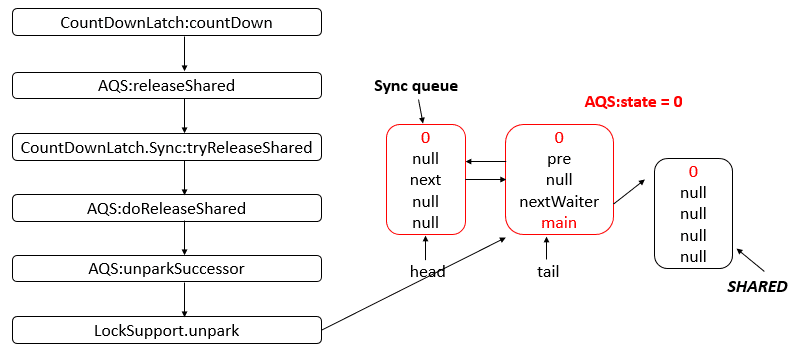
说明: 经过调用后,AQS的state为0,并且此时,main线程会被unpark,可以继续运行。当main线程获取cpu资源后,继续运行。
- main线程获取cpu资源,继续运行,由于main线程是在parkAndCheckInterrupt函数中被禁止的,所以此时,继续在parkAndCheckInterrupt函数运行。
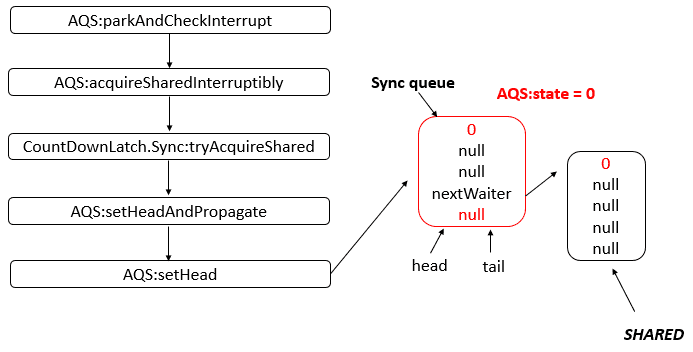
说明: main线程恢复,继续在parkAndCheckInterrupt函数中运行,之后又会回到最终达到的状态为AQS的state为0,并且head与tail指向同一个结点,该节点的额nextWaiter域还是指向SHARED结点。
更深入理解
写道面试题
实现一个容器,提供两个方法,add,size 写两个线程,线程1添加10个元素到容器中,线程2实现监控元素的个数,当个数到5个时,线程2给出提示并结束.
使用wait和notify实现
import java.util.ArrayList;
import java.util.List;
/**
* 必须先让t2先进行启动 使用wait 和 notify 进行相互通讯,wait会释放锁,notify不会释放锁
*/
public class T2 {
volatile List list = new ArrayList();
public void add (int i){
list.add(i);
}
public int getSize(){
return list.size();
}
public static void main(String[] args) {
T2 t2 = new T2();
Object lock = new Object();
new Thread(() -> {
synchronized(lock){
System.out.println("t2 启动");
if(t2.getSize() != 5){
try {
/**会释放锁*/
lock.wait();
System.out.println("t2 结束");
} catch (InterruptedException e) {
e.printStackTrace();
}
}
lock.notify();
}
},"t2").start();
new Thread(() -> {
synchronized (lock){
System.out.println("t1 启动");
for (int i=0;i<9;i++){
t2.add(i);
System.out.println("add"+i);
if(t2.getSize() == 5){
/**不会释放锁*/
lock.notify();
try {
lock.wait();
} catch (InterruptedException e) {
e.printStackTrace();
}
}
}
}
}).start();
}
}
输出:
t2 启动
t1 启动
add0
add1
add2
add3
add4
t2 结束
add5
add6
add7
add8
CountDownLatch实现
说出使用CountDownLatch 代替wait notify 好处?
import java.util.ArrayList;
import java.util.List;
import java.util.concurrent.CountDownLatch;
/**
* 使用CountDownLatch 代替wait notify 好处是通讯方式简单,不涉及锁定 Count 值为0时当前线程继续执行,
*/
public class T3 {
volatile List list = new ArrayList();
public void add(int i){
list.add(i);
}
public int getSize(){
return list.size();
}
public static void main(String[] args) {
T3 t = new T3();
CountDownLatch countDownLatch = new CountDownLatch(1);
new Thread(() -> {
System.out.println("t2 start");
if(t.getSize() != 5){
try {
countDownLatch.await();
System.out.println("t2 end");
} catch (InterruptedException e) {
e.printStackTrace();
}
}
},"t2").start();
new Thread(()->{
System.out.println("t1 start");
for (int i = 0;i<9;i++){
t.add(i);
System.out.println("add"+ i);
if(t.getSize() == 5){
System.out.println("countdown is open");
countDownLatch.countDown();
}
}
System.out.println("t1 end");
},"t1").start();
}
}
参考文章
- 文章主要参考自leesf的https://www.cnblogs.com/leesf456/p/5406191.html,在此基础上做了增改。
- https://www.jianshu.com/p/40336ef1f5fe